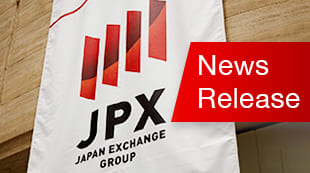Search results 3301-3310 / 10518
- sort:
- relevance
- latest

Access (Osaka) | Japan Exchange Group Map Nearby stations Contact Tokyo Osaka Global Offices Google Maps Direct from Kitahama Station Exit #1B (Sakaisuji Line) Direct from Kitahama Station Exit #27 & 28 (Keihan Line) (Note) ・There is no visitor car parking available and public transportation is recommended. 1-8-16, Kitahama, Chuo-ku, Osaka 541-0041, Japan (Reception: 1st floor) Osaka Exchange, Inc. (Head Office) Japan Exchange Group, Inc. (Osaka Head Office) Tokyo Stock Exchange, Inc. Tokyo Commodity Exchange, Inc. JPX Market Innovation & Research, Inc. Japan Exchange Regulation Japan Securities Clearing Corporation Tel: +81-6-4706-0800 (Note) ・Open on weekdays: 8:45 - 16:45...

Non‐Cancel Period (NCP) | Japan Exchange Group Non‐Cancel Period (NCP) Outline On-demand strike prices Non‐Cancel Period (NCP) Order to Trade Ratio (OTR) Hard Block To prevent excessive price fluctuation due to order modifications/cancellations just before Itayose, OSE introduces one‐minute periods during which investors cannot change or cancel their orders for certain products. Products All contract months of the products below. Nikkei 225 Futures Nikkei 225 mini Nikkei 225 micro Futures TOPIX Futures (excluding mini-TOPIX Futures) Gold Standard Futures Gold Mini Futures Gold Rolling-Spot Futures Options on Gold Futures Silver Futures Platinum Standard Futures Platinum Mini Futures Platinum Rolling-Spot Futures Palladium Futures CME Group Petroleum Index Futures Soybean Futures Azuki (Red Bean) Futures Corn Futures Platts Dubai Crude Oil Futures Gasoline Futures Kerosene Futures Gas Oil Futures Chukyo Gasoline Futures Chukyo Kerosene Futures East Area Baseload Electricity Futures West Area Baseload Electricity Futures...

Past Initiatives | Standardization of Trading Unit | Japan Exchange Group Determination of the Deadline for the Transition to 100-Share Trading Units (announced on Dec. 17, 2015) Progress in Standardization to 100-Share Trading Units (announced on Apr. 24, 2015) Partial Amendments to Securities Listing Regulations, etc. for Standardization of Trading Units (announced on June 26, 2014) End of the Period of Consolidation to Two Types of Trading Units (100 Shares and 1,000 Shares) and Start of the Transition Period for the Standardization to 100 Shares (announced on Mar. 17, 2014) Determination of the Deadline for the Transition to Trading Units of 100 and 1,000 Shares (announced on Jan. 19, 2012) Postponement of Deadline for Transition to Trading Units of 100 and 1,000 Shares (announced on Apr. 28, 2011) Request for Standardization of Trading Units (announced on Nov. 24, 2010) Action Plan for Consolidation of Trading Units (announced ...

Q&A on Standardization of Trading Units | Japan Exchange Group Q1: What procedures are required under the Companies Act to convert to a 100-share trading unit? Q2: Apart from the standardization of trading units, the listing rules require that efforts be made to move to and maintain a desirable minimum investment unit level (less than 500,000 yen). Which of these should be prioritized? Q3:What are some possible ways to mitigate or avoid a reduction in minimum investment unit level? Q4: We would like to understand how much the number of shareholders will change as a result of the transition to the 100-share unit. Q5: My company already has a 100-share trading unit, but the minimum investment unit level is more than JPY 500,000. Is it possible to change the number of shares per Share Unit when reducing the minimum investment unit? Q6: If we ...

List of Companies that have Changed the Number of Shares per Share Unit | Japan Exchange Group Number of Listed Companies by Number of Shares per Share Unit Standardization of Trading Units Past Initiatives Q&A on Standardization of Trading Units List of Companies that Changed the Number of Shares per Share Unit (Trading Unit) Survey Results Information on all listed companies that have changed the number of shares per Share Unit (trading unit) with an effective date of April 1, 2013 or after can be found in the list below. List of Companies that have Changed the Number of Shares per Share Unit (Trading Unit) (as of Oct. 1, 2018) (in Japanese only) The number of listed companies by number of shares per Share Unit as of October 1, 2018. The number of listed companies with a 100-share units was 3,600. *This list covers issuers of domestic stock ...

Survey Results | Standardization of Trading Unit | Japan Exchange Group Survey on Standardization of Trading Units (announced on Dec. 17, 2015) Survey on Standardization of Trading Units (announced on Feb. 4, 2011) Standardization of Trading Units Past Initiatives Q&A on Standardization of Trading Units List of Companies that Changed the Number of Shares per Share Unit (Trading Unit) Survey Results TSE conducted a survey to ascertain the status of consideration, etc., regarding the transition of listed companies with 1,000-share units to 100-share units during the final stage of the "Action Plan for Standardization of Trading Units" (transition period for standardization of 100-share units). Summary Regarding the status of consideration of the transition to 100-share unit, only about 20% of the companies stated that they are "considering the transition, including management," while more than 80% of the companies stated that they are "not considering the transition" ...

Background of Introduction | Electronic Voting Platform, etc. | Japan Exchange Group Increased Awareness of Voting among Institutional Investors Practical Issues in Voting Rights Exercise Electronic Voting Platform Background of Introduction Overview of Services Benefits for Participants Efforts to Increase Participation During the bubble economy of the 1990s, mutual cross-shareholdings were dissolved, and the composition of shareholders in Japan‘s securities markets changed dramatically. According to the shareholding ratios by owner in the annual shareholder distribution survey conducted by stock exchanges in Japan, banks and life and non-life insurers held 33.6% of the total market in March 1990, but this share dropped to 24.0% in March 2000 and to 12.9% in March 2004. On the other hand, the share held by trust banks and foreign investors, which was 14.2% of the total market in March 1990, rose to 23.3% in March 2000 and 37.1% ...

Overview of Services | Electronic Voting Platform, etc. | Japan Exchange Group Information Flows on the Platform Contractual Relationships, etc. System Safety Electronic Voting Platform Background of Introduction Overview of Services Benefits for Participants Efforts to Increase Participation The following explains the flow of information on the platform according to the "Conceptual Diagram of the Platform" shown above. The first step is the flow of agenda information from the issuer to the instructing parties. First, the issuer registers the convocation notice information via TDnet. Upon receiving this information, the platform will classify agenda items based on codes for the predetermined classification for each agenda item of the general meeting, and post it on the platform's website along with the PDF file on the date of dispatch of the convocation notice. The instructing parties will be able to view this information directly. The agenda information registered on the platform will be provided ...

Benefits for Participants | Electronic Voting Platform, etc. | Japan Exchange Group Benefits for Institutional Investors Advantages for the Issuer Electronic Voting Platform Background of Introduction Overview of Services Benefits for Participants Efforts to Increase Participation There are four possible benefits of participation by institutional investors. Centralized Portfolio Management Institutional investors participating in the platform will use a dedicated screen to give instructions for the exercising of voting rights, as described above. The site allows institutional investors to access information on the AGMs of all participating issuing companies in which they hold shares with a single login, eliminating the need to repeatedly log in and log out. On the screen, only the issuing companies in which shares are held are listed, and by clicking on the company name, the number of potential shares can be confirmed and instructions for the exercising of voting rights can be given for each account held in ...

Efforts to Increase Participation | Electronic Voting Platform, etc. | Japan Exchange Group Toward Increasing Participation by Issuers Electronic Voting Platform Background of Introduction Overview of Services Benefits for Participants Efforts to Increase Participation The number of issuers participating in the platform has been increasing year by year since the Corporate Governance Code was formulated in 2015 and the METI Study Group on Promoting the Electronicization of General Meeting Processes in 2016 recommended promoting the use of the platform. The 2021 revision of the Corporate Governance Code called for further promotion of use by Prime Market-listed companies, and since the market restructuring, the participation rate of Prime Market-listed companies has remained at over 95%. As an increasing number of issuers join the platform, the number of institutional investors who hold voting rights in those issuers is also significantly increasing as they recognize the significance of using the platform. The increase ...














